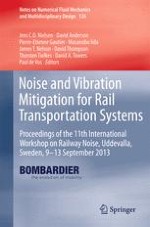The book reports on the 11th International Workshop on Railway Noise, held on
9 – 13 September, 2013, in Uddevalla, Sweden. The event, which was jointly organized
by the Competence Centre Chalmers Railway Mechanics (CHARMEC) and the
Departments of Applied Mechanics and Applied Acoustics at Chalmers University of
Technology in Gothenburg, Sweden, covered a broad range of topics in the field of railway
noise and vibration, including: prospects, legal regulations and perceptions; wheel and
rail noise; prediction, measurements and monitoring; ground-borne vibration; squeal
noise and structure-borne noise; and aerodynamic noise generated by high-speed trains.
Further topics included: resilient track forms; grinding, corrugation and roughness;
and interior noise and sound barriers. This book, which consists of a collection of peer-reviewed
papers originally submitted to the workshop, not only provides readers with an
overview of the latest developments in the field, but also offers scientists and engineers
essential support in their daily efforts to identify, understand and solve a number of
problems related to railway noise and vibration, and to achieve their ultimate goal of reducing the environmental impact of railway systems.
